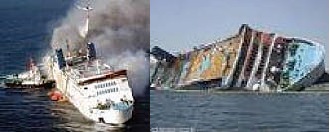
Off Manila in2004: An hour before midnight on 27 February, the Super ferry 14 sailed from Manila bound for Cagayan de Oro. Not long after sailing, an improvised bomb with only 8 pounds of TNT hidden in a television set exploded in the lower, crowded decks of the vessel. The ensuing explosion tore through the vessel, igniting a fi re which engulfed the ship. Through a valiant effort of quick responding vessels in the area, a majority of the recorded 899 passengers and crew were rescued. However, at least 116 were confirmed lost in this tragedy, which included six toddlers less than fi ve years old and six students on a high school championship team set to compete in a journalism contest.
On May2, 2011, Osama bin Laden was killed by gunshot wounds to the head and chest during a raid on his compound in Pakistan. This death of the founder of al-Qaeda, the ultra-militant Islamist organization, will carry mixed results globally.
The impact to South East Asia is a high probability of terrorist attack(s) targeted against the maritime community in the region and in the Philippines in particular. While many applaud the death of this well-known mass murderer and terrorist figure, security professionals will take this occasion to relook at their current vulnerabilities and gaps in security coverage.
Terrorist actions in the Philippines are not new, and as the Super- Ferry 14 attack illustrates, maritime attacks can occur in this region and will occur more frequently if specific actions are not taken to mitigate risks. A December 2010 GAO report to the US Congress stated: “Ferries and their facilities in the Philippines have repeatedly been targeted by terrorists.
For example, successful bombings on Philippine ferries killed or wounded at least 130 people in 2004 and 2005. Attacks on ferries and their facilities have continued, and in 2009 there were three more attempted bombings in the Philippines.” This report goes on to state that Ferries are not the sole terrorist targets in the maritime industry, but just the one specifically addressed by this report.
Target Analysis and Methodologies
What makes the Maritime Industry stand out as key targets? Terrorist acts are intentionally symbolic; often the media reporting is much more important than the sheer damage itself. Military targets are selected to damage or destroy the enemy’s command & control, logistics nodes, military stores, and the enemy’s forces themselves. A terrorist target is normally selected for the impact or image it will portray to a larger world audience. The maritime industry has many vulnerable targets, such as ships and port/harbor facilities. Many multinational companies operate vital port facilities such as oil depots or on/off loading piers for foodstuffs or other valuable cargo. It does not matter that those killed or wounded are innocent civilians and that the target has no military value. Rather, the symbolism and media coverage of the event is the ultimate aim.
Although there may be quick, reactive small scale attacks, these are the easiest to spot and prevent, but are not the most dangerous threats.
It is safe to assume that well planned and coordinated attack(s) against key targets are being planned now; where and when are key questions. The potential targets SELECTED for these attacks will be the subject of surveillance and study to determine weaknesses. The most secure targets are often sidestepped for targets that have apparent security lapses or lax procedures. There have been several substantiated in- stances of surveillance operations underway, and studies conducted of methods to attack targets (such as by underwater divers or remotely piloted vessels/vehicles) which were not executed because of the difficulty to successfully attack the target. If, after analysis of potential target, the probability of successful attack is slim, most likely the terrorist will search for an easier target – unfortunately there are too many “easy” targets available. These surveillance activities must be a primary area of interest, and “counter-surveillance” measures implemented.
Protecting against Terrorist Attacks
A committed and determined terrorist that studies potential targets is a most dangerous adversary. You must be just as committed to the security of your organization; then, threats can be addressed and mitigation measure implemented to reduce your exposure. The following are actions that should be implemented {or updated} to enhance your anti-terrorism security posture:
Review your current Security Assessment, with particular focus on what makes your facility/ship stand out as a target against the back- drop of many other potential targets (such as connected to Multinational company; energy/oil & gas related; large population usage; etc.). If you do not have a current security assessment, this is a “MUST DO” first step.
- REVIEW YOUR CURRENT COUNTER SURVEILLANCE MEASURES IN PLACE. Do you have any? If not, this needs to be ad- dressed. Targets are not haphazardly hit, but detailed surveillance conducted – often over a long period of time. Aside from some CCT-Vs and security guards, there needs to be training for these personnel to observe potential surveillance being conducted. Records need to be kept and analysis of suspicious activity tracked over time. For port facilities, look at what “Google-Earth” shows of your facility, the terrorist will look this up on the internet for sure!
- Review your screening procedures, are they only a security façade or truly adequate? {The Dec 2010 GAO Report previously mentioned recommended enhanced screening for cargo and vehicles as a key recommendation}
- Have a “security network” meeting frequently, at least once per quarter: members should include other like facilities in the larger area, government security officials, and other key businesses that might be targets (such as mass transit/bus, airports, etc.). At least one major agenda item of this meeting should include a review of any suspicious activity being noted. Terrorist surveillance will often look at several potential targets in the general vicinity. Comparing notes may show similarities which go unnoticed when viewed independently.
- Review and update your key contact list, not just for personnel within your organization, but for the public security organizations that support your facility and organization on a larger scale.
- Review and update your Emergency Response plan, and the first step here is to ensure your organization’s Crisis Response Team (or whatever name you designate) is current and everyone knows their duties. Ensure you have multiple means of contact (e-mail, primary telephone number, alternate contact number, etc.). Conduct a drill or table top exercise in the next few weeks if you haven’t done so recently, and at least quarterly thereafter.
- Conduct a security/safety audit of your facilities communication system, security equipment (CCTV; access control; perimeter control system; alarm systems; etc.), and safety equipment. One area often not addressed: look at your waterside security; do you have a “barrier system” (if not actual barrier then some type of watercraft patrols, radar surveillance, or optical detection system)
- It should go without saying: Review and update all aspects of the ISPS Code: Port Facility & Ship Security Assessments & Plans: even if not “overdue”, these should be reviewed at least semi-annually.
Summary
The death of Osama bin Laden will result in attempts to demonstrate that al-Qaeda and its offshoots still have the ability to conduct terrorist attacks globally. Rather than being reactive after an attack occurs, the time is now to take action to harden our maritime facilities and prevent our facilities or ships from being easy prey to such attacks. Prevent your ship of maritime facility from being “selected” because of lax procedures, and reduce your vulnerability. For additional questions on this subject, you can contact me at “medina. joseph@theapssgroup.com”.
BGen Joseph Medina USMC (Ret) is the Director, Maritime Security for the Asia Pacific Strategies & Solutions (APSS) Group. He was formerly Commander of Expeditionary Strike Group THREE, CTF 58 (5th Fleet), CTF 79 (7th Fleet). He is a subject matter expert and frequent speaker on Maritime Security issues.
